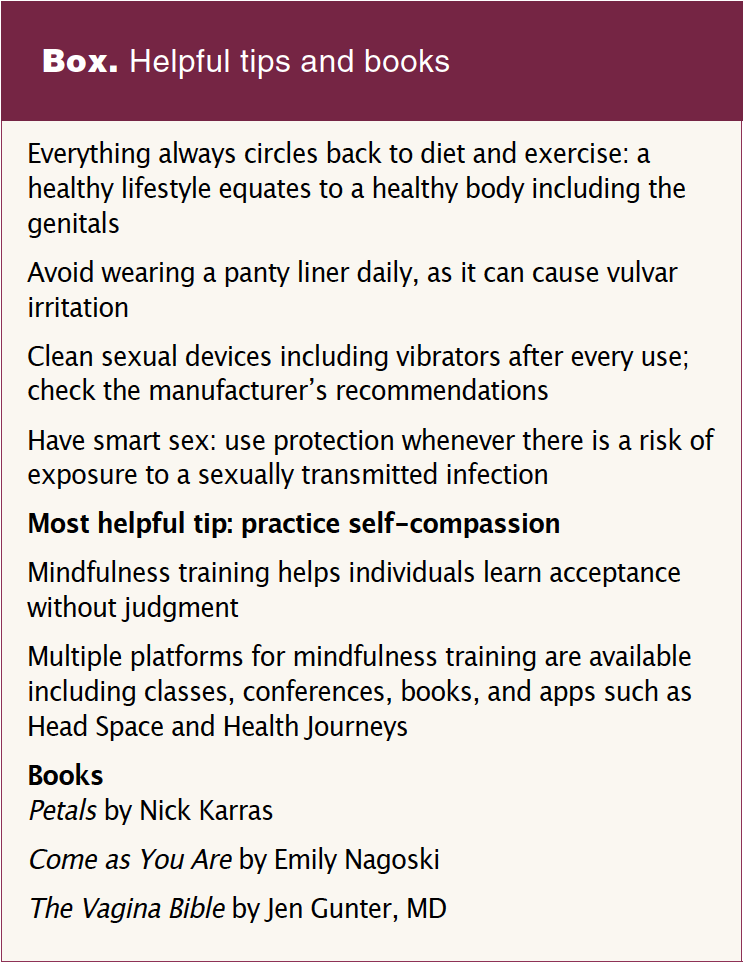Working in gynecology as a women’s health nurse practitioner, it is commonplace for me to hear my patients make self-disparaging comments such as: how can you look at vaginas all day, aren’t vaginas disgusting, how can you stand to do this job? Unfortunately, I also hear patients apologize for dry skin on their legs, chipped toenail polish, or that they are in between waxes. Both of these types of comments sadden me that women think so poorly of their bodies and feel a need to uphold a strict beauty standard even at an office visit. When feminine hygiene advertisements teach women that they need their products to be clean and fresh, when belittling is calling someone a douchebag, women are sent the message that they are inherently dirty or unclean. Moreover, I fear that despite my reassurances to my patients, I cannot change this negative narrative.
Case study
Beth is a 37-year-old patient referred to me with complaints of vaginal irritation and inability to have penetrative intercourse due to pain and chafing that started 1 year prior. Numerous providers in the gynecology department had treated her presumptively for bacterial vaginosis and yeast with no improvement. Beth also had a dermatology consult and was prescribed clindamycin and hydrocortisone lotion for contact dermatitis, which she states was ineffective. When I met Beth, she told me she was unable to use soap to clean her genitals due to discomfort and had been applying an olive oil and bee’s wax-based vulvar moisturizer and using a silicone-based lubricant with minimal relief of her symptoms. On examination, I noticed a lightening and thickening of the vulvar and groin tissue but no other skin color or architectural changes. There was scant white vaginal discharge with no odor and a normal wet mount evaluation. My differentials were lichen sclerosus or lichen simplex chronicus, and I obtained a vulvar biopsy.
The findings of the biopsy were parakeratosis with a superficial lymphocytic infiltrate and noted by the dermatology pathologist as “These findings are nonspecific. Contact dermatitis cannot be ruled out.” Because of the lichenified tissue, I treated her for lichen simplex chronicus with a high-potency steroid ointment and had her follow up with me in 4 weeks. At the follow-up, she stated that the irritation was only somewhat better and there had been no improvement in the tissue color changes. Beth stated her current vulvovaginal routine was application of the high-potency steroid ointment and vulvar moisturizer 1 to 2 times daily. I reviewed with her how and where to apply the ointment and had her follow up with me in another month. At the follow-up appointment, there was still no improvement in the skin color changes and she was having an increase in vulvar irritation. I referred her to our dermatology department for a consult, during which Beth confided to the dermatology nurse practitioner that she was scrubbing her vulva and groin 4 to 5 times daily. Vulvar and vaginal hygiene practices were reviewed, and zinc oxide was recommended to heal the tissue. When I saw Beth for the next follow-up appointment, she was still concerned about the skin color changes. When I questioned her further about how often she was washing her groin and genitals, it was then that she confided about her fear of vaginal odor. Her boyfriend had told Beth that he had previously been with other women whose genitals smelled bad and he was refusing to have oral sex with her. She was so consumed with worry that she too would smell, that she was cleaning her vulva and vagina multiple times a day and sometimes using isopropyl alcohol.
What society has told women about their genitals
During the late 19th century, there was an increased awareness of the importance of cleanliness for disease prevention. Although douching was first used for contraception, when it was found to be ineffective, advertisers needed women to have a new reason to douche.1 The phrase “feminine hygiene” began as a euphemism for douching with products advertised for the promotion of health and cleanliness.1 Throughout the 1920s and 1930s, advertisements for douching expanded to promote products as able to help women achieve social distinction and desirability.1 By the 1940s, douching was being advertised mainly for deodorizing and by the 1960s, the market expanded to include several vaginal deodorant sprays.1
There remains today a profitable industry marketed as women’s hygiene products. In 2020, the global feminine hygiene product market was valued at 38.9 billion dollars and is expected to reach 68.7 billion dollars in 2030.2 It is important to reflect on what message the industry has to sell to women to remain profitable and what impact this has had on women.
A literature review of women’s perceptions of body image shows an overall negative perception and a fear of odor. Furthermore, consistent with the data, the majority of women surveyed are using feminine hygiene products. A qualitative study of 25 women who were asked to describe the least likely body they would like to inhabit found five themes: defective femininity, “freak” body parts, fear of excessiveness, dread about a specific person’s body, and disgust about smelliness.3 The VOGUE Group Initiative examined Canadian women’s use and reason for vaginal hygiene products.4 Vaginal cleanliness and freshness was mentioned in 47 of the 49 interviews, and there was a fear of odor and consequent feelings of shame and embarrassment if they suspected anyone else would notice an odor.4 Furthermore, a survey of 1,435 Canadian respondents found that 95% of the women used at least one vaginal hygiene product.5 Lastly, a qualitative study that examined 20 women’s narratives about their genitals discovered seven themes: dirty or gross, needing maintenance, unknown or frustrating, unnatural, comparative, ambivalent, and affirmative.6 The author noted a common thread that was present in each of these themes: men’s appraisals of vaginas significantly affected the women’s feelings about their own vaginas.6
How can we help women? We can start by educating them about their bodies.
Physiology of the vulva and vagina
The vulva and vagina are the only areas in a woman’s body that have tissue derived from all three embryologic origins: ectoderm, endoderm, and mesoderm.7 The mons pubis, labia majora and minora, clitoral prepuce, and perineum are derived from embryonic ectoderm and have characteristics similar to the skin in other parts of the body.8 This tissue is keratinized and composed of stratified epithelium and although it is more hydrated than exposed skin, pathology can develop if the tissue becomes too moist. Like other areas of the body, the tissue in the vulva acts as a barrier. Once the epithelium is compromised, pruritus may occur due to microbial colonization, mechanical irritation, or chemical injury.9 In addition, the damaged epithelium releases cytokines that activate the immune system and subsequent itch-sensing nerve fibers. Furthermore, like other areas of skin in the body, the vulva has both sebaceous glands and sweat glands from which secretions when mixed with bacteria may produce a mild odor.
The mucosa of the vestibule is derived from the endoderm and is composed of nonkeratinized cells.8 The vagina, hymeneal membrane, bladder trigone, and posterior urethral wall are derived from the mesoderm and are also mucosal membranes with nonkeratinized cells.8 Both of these mucosal membranes are usually moist from secretion from the glands and transudate from the cervix and vagina. Loss of moisture can cause irritation, dryness, and pain.8 Bacteria in the vagina comprise the vaginal microbiome and are important for immunity. There may be a slight odor from the byproducts of the bacteria.
How else can we help women? We can teach them about vulvar and vaginal hygiene10:
- Only once daily bathing or showering is necessary
- Avoid long soaks in hot water that may cause vulvar dryness
- Use only the fingertips to clean and never scrub
- Soap is not necessary, but if used it should be mild and hypoallergenic. Avoid pure soap, which can be drying. Soap with essential oils may cause irritation, and body wash usually contains chemicals that can cause irritation
- Wet wipes and baby wipes may contain alcohol and chemicals that can cause irritation
- Douching is not recommended
- Feminine hygiene products are discouraged due to potential exposure to irritants
Key points for the nurse practitioner
Create a safe space for your patient so that she can feel heard and validated. Inquire about her vulvar and vaginal hygiene, including what products she uses and the frequency. Meet your patient where she is comfortable. Perhaps she is not ready to stop using soap, but she is willing to stop using the purple-scented lavender soap in exchange for a milder soap. Explore any negative connotations and be mindful of the messages our culture is sending to women about their bodies. When I discovered Beth’s fear of odor and the impact of her partner’s comments, I referred her to a psychologist that specializes in female sexual health to help give her the words and guidance for having a conversation with her partner.
As mentioned before, I am fearful that I won’t be able to change the narrative our culture sends to women about their bodies, but I try to remain optimistic. And to answer my patients’ questions: I love my job, no I don’t find vaginas disgusting, and no one ever has to moisturize, paint, or wax for my benefit.
Jean M. Marino is Senior Women’s Health Nurse Practitioner in the ob/gynecology department and Women’s Sexual Health Division in the urology department at the University Hospitals Cleveland Medical Center in Cleveland, Ohio. The author has no actual or potential conflicts of interest in relation to the contents of this article.
Womens Healthcare. 2023;11(2):32-34. doi: 10.51256/WHC042332
References
1 Ferranti M. From birth control to that “fresh feeling”: a historical perspective on feminine hygiene in medicine and media. Women Health. 2009;49(8):592-607.
2 Global Feminine Hygiene Product Market Report 2022. Penetration of international brands in the untapped market has propelled demand. Research and Markets. March 24, 2022. https://www.prnewswire.com/news-releases/global-feminine-hygiene-products-market-report-2022-penetration-of-international-brands-in-the-untapped-market-has-propelled-demand-301510292.html.
3 Fahs B. The dreaded body: disgust and the production of “appropriate” femininity. J Gender Studies. 2017;26(2):184-196.
4 Jenkins AL, Crann SE, Money DM, O’Doherty KC. “Clean and fresh”: understanding women’s use of vaginal hygiene products. Sex Roles. 2018;78(9):697-709.
5 Crann SE, Cunningham S, Albert A, et al. Vaginal health and hygiene practices and product use in Canada: a national cross-sectional survey. BMC Womens Health. 2018;18(1):52.
6 Fahs B. Genital panics: constructing the vagina in women’s qualitative narratives about pubic hair, menstrual sex, and vaginal self-image. Body Image. 2014;11:210-218.
7 Goldstein I, Clayton AH, Goldstein AT, et al. Female Sexual Function and Dysfunction: Diagnosis and Treatment. Wiley Blackwell; 2018.
8 ISSVD. Vulvovaginal disorders: an algorithm for basic adult diagnosis and treatment. https://vulvovaginaldisorders.org/annotation/annotation-h/.
9 Raef HS, Elmariah SB. Vulvar pruritus: a review of clinical associations, pathophysiology and therapeutic management. Front Med. 2021;8:649402.
10 ISSVD. Vulvovaginal disorders: an algorithm for basic adult diagnosis and treatment. General vulvar care. https://vulvovaginaldisorders.org/handouts/GeneralVulvarCare.pdf.
11 Edwards, D, Panay, N. Treating vulvovaginal atrophy/genitourinary syndrome of menopause: how important is vaginal lubricant and moisturizer composition? Climacteric. 2016;19(2);151-161.


